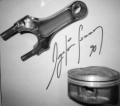Radiator
by , 12-03-2013 at 10:37 PM (2523 Views)
Finally, managed to find some time updating the blog.
What a busy week......
Hope to find extra time for replying back to two comments,
one from greenberet and the other one from Senninha.
Started to work on another NSX.
The service menu is to replace the old and tired radiator with
the Koyo one, replace O2 sensors, repair audio head unit, etc.
Following on from the introduction of Koyo Radiator,
itís time for the installation.
A while ago, I carried out the Engine Refresh service with
Health Check on this NSX and although the vacuum leak check on
the cooling system found nothing wrong with the radiator,
there was noticeable trace of old coolant seepage.
Considering the age and mileage covered by the old OEM radiator
and also the future usage of this NSX,
recommended the owner to replace it with the Koyo one.
As mentioned many times, the radiator is a consumable parts.
Itís not something you can keep using forever even if itís not leaking.
Sooner or later, the OEM one will crack at the plastic tank located at
the top and bottom.
Also, the cooling efficiency is significantly reduced over the years.
Lots of people discuss about what engine oil to be used but not much
about the oil temperature.
Especially, this is important for the C32B owners.
The cooling system design is the same between C30A and C32B even
when C32B can produce higher power output out of the factory.
While you wonít notice the following on the normal street driving,
if you push hard for a long period or if you take your C32B on track
in hot summer, you will see the change in coolant/oil temperature and
you can visually notice it on the coolant temperature gauge.
So, please replace your radiator if the fins were flattened over the years.
Rinsed the new Koyo rad thoroughly and took the OEM one out.
This is why I tell so many times that the radiator is a consumable parts.
Almost 50% of the fin were squashed and flattened that
not enough air was passing through the core.
The close up is like this.
When itís new, it will look like this.
Shows the age of the parts.
Koyo radiator is really well made and the cooling fan duct just
bolts on with ease.
No modification required.
And it just slides in.
Vacuum leak check carried out and after 45min,
happy with the result so filled with Honda Type-2 coolant.
Quick fire up, double checked the installation,
operated the cooling fan and
will adjust the coolant level later.
Done.




 Email Blog Entry
Email Blog Entry

